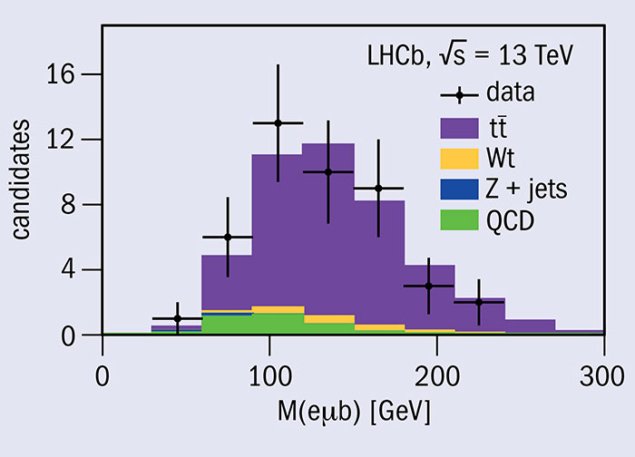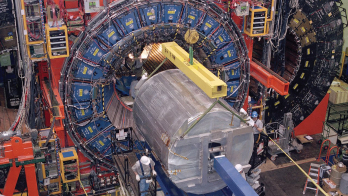
Measurements of top-quark production at high rapidity in LHC proton–proton collisions provide a unique probe of the Standard Model of particle physics (SM). In this kinematic region, top-pair production is characterised by sizeable rates of quark–antiquark and quark–gluon scattering processes (in addition to gluon–gluon fusion), potentially enhancing sensitivity to physics beyond the SM. Precision measurements at high rapidity can also be used to probe the inner structure of the proton, constraining parton distribution functions at high “Bjorken-x” values and reducing uncertainties on the background process rates in other measurements. Such a “forward” region is uniquely covered with full instrumentation at the LHC by the LHCb detector.
LHCb has now made its first measurement of top quark production using Run-2 data collected in proton–proton collisions at the energy of 13 TeV. This is the third measurement from LHCb in the sector of top physics and is also the first from the collaboration to study the dilepton channel.
The measurement was performed by reconstructing dilepton decays of the top-pair system, looking for high-momentum electrons, muons and b-jets in the acceptance of the LHCb detector, using data recorded in 2015 and 2016. About 87% of selected events correspond to the signal process, making this the highest purity measurement of top physics at LHCb to date. Within the region covered by LHCb, the production cross-section of top-quark pairs (multiplied by the branching fraction to the measured final state) was determined to be 126 fb with a precision of about 20%, with the uncertainty dominated by statistical effects. The measurement is compatible with the SM predictions.
Such measurements are only now possible at LHCb owing to the increased proton collision energy (13 TeV) of LHC Run 2. While the overall cross section for top-pair production at the LHC has increased by roughly a factor of three with respect to the 8 TeV proton–proton collisions recorded in Run 1, the cross section within the forward coverage of LHCb has increased by about one order of magnitude.
LHCb expects to accumulate, by the end of Run 2, four times more data than that used in the present analysis. With future runs and the upcoming and planned detector upgrades, LHCb will enter a new era of precision studies of forward top physics.
Further reading
LHCb Collaboration 2017 LHCb-PAPER-2017-050.
LHCb Collaboration 2016 LHCb-PAPER-2016-038.
LHCb Collaboration 2015 LHCb-PAPER-2015-022.





